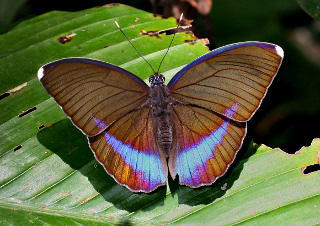Butterfly farm to be built at Twiga Cement's mining sites in Tanzania
Community and Forum → Blog → Butterfly farm to be built at Twiga Cement's mining sites in Tanzania
Lev Bely, 10.11.2012 22:32

Twiga Cement (Tanzania Portland Cement Company, TPCC), manufacturer of portland cement in Tanzania, is about to build a butterfly farm at their Wazo Hill mining sites in Dar es Salaam, for to “improve biodiversity and ecological systems” of the area “and even attract tourists”.
Kelvin Ngongolo from the Tanzania Wildlife Research Institute, Kingupira Wildlife Research Centre offered this project after he won third place in The Quarry Life Award, an international competition that TPCC first led in Tanzania for their project “Can Re-vegetation of Wazo Hill Quarry Increase Butterfly Species Diversity and Abundance?”
In fact, Twiga Cement vitally needs to have butterfly farm or something of the kind appeared at their limestone mining sites. Even then it's gonna take some time for to the quarrel between TPCC and locals in Chasimba village would be settled. The latter keep occupying land intended for gravel mining, and they can't seem to retreat: the area simply lacks good agricultural land.
Ngongolo's research shows that there are many endemic species of butterfly around, which could not only attract tourists but themselves enhance local ecology. Without such butterfly farm the territory is likely to be eventually destroyed by mining. Polluted air and industrial waste are especially crushing.
So they explored limestone and gravel mining sites, both new and already destroyed, and found over 36 butterfly species that habited the area. The expert says, they will create a multiplier effect through pollination causing an absolute recovery of flora and the fauna and thus sustaining biodiversity and the ecology of the region.
As he explained, “…butterflies play an important role in ecosystems, acting as a pollinator, food source they are an all around indicator of the ecosystems’ well being…”.
Endemic butterflies were spotted as well in other parts of Tanzania, including the East Usambara Mountains.
Limestone is a wide-spread sedimentary rock that makes up 12% of all sedimentary rocks. It's quite multifunctional, widely used and mined all over the world. Limestone has been one of the most popular building materials for many centuries.
It consists mainly of calcium carbonate (used for school chalk) and constituted by sediment accumulations at the bottom of the ocean sourced from animal sinks and plant remnants. This layer has been constantly growing. Animal body structures like shells are a particularly good source of limestone.
Sadly limestone mining damages the environment since it produces highly alkaline dust that pollutes the air. This results in various health issues, especially in those who already have respiratory problems. Dust is as well harmful to plants: it occludes and injures their internal structures, damages leaf's epidermis and simply poisons the plant that can negatively impact its lifespan.
IPP Media, http://www.ippmedia.com
Photo: Euphaedra harpalyce, http://www.learnaboutbutterflies.com
All the rest posts on: Africa, species recovery, science, danger zone, ecology
Comments
New comment
Note: you should have a Insecta.pro account to upload new topics and comments. Please, create an account or log in to add comments.
* Our website is multilingual. Some comments have been translated from other languages.
Random species of the website catalog
News
- 31.12.2024: Если нужно загрузить на сайт много фотографий
- 10.12.2024: Новое поле в «Поиске энтомологов»
- 05.12.2024: Insecta.pro maps: filter by taxon
New photos (22.02.2025)
Fresh from the community
- 10:56, P. Khramov: / → Pyrgus malvae / Nikolay Greb...
- 10:55, P. Khramov: Not identified → Lasiocampa quercus...
- 7:37, N. Grebennikov: Lasiocampa quercus....
Popular insects
Recommended blog topics
- ICZN Election of Commissioners
- Meanwhile, in Kotelnich
- Entomologist? What kind of job is it?
- The butterfly collection at the California Academy of Sciences



























